Exploiting Method Development for Food Analysis Using High Performance Liquid Chromatography-Modelling
The Column
Food analysis is often handled less thoroughly than pharmaceutical analysis because of the smaller life-threatening risk expected from foodstuffs. However, food analysis is still a major focus for chromatographers from a scientific and an analytical point of view. Adoption of modern “in‑silico” techniques, such as chromatographic modelling, offer analysts new possibilities for method development.
Photo Credit: Fotokostic/Shutterstock.com
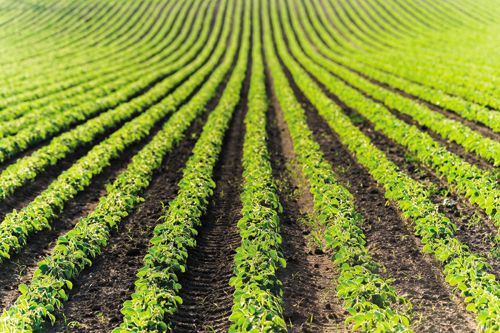
Arnold Zöldhegyi, Imre Molnár, and Hans-Jürgen Rieger, Molnár-Institute, Berlin, Germany
Food analysis is often handled less thoroughly than pharmaceutical analysis because of the smaller life-threatening risk expected from foodstuffs. However, food analysis is still a major focus for chromatographers from a scientific and an analytical point of view. Adoption of modern “inâsilico” techniques, such as chromatographic modelling, offer analysts new possibilities for method development.
High performance liquid chromatography (HPLC) work in the food industry forms an integral part of analytics, occupying approximately one-fifth of the daily users (1,2), and its well-earned role should receive more attention.
Food analysis encompasses a broad spectrum of analytical challenges, including determining heterogeneous bioactive compounds, residues, pesticides, toxins, and allergens in various and often very complex matrices.
Despite this complexity, in most cases no systematic analytical method development is embraced, which can result in underperforming installations, robustness problems, the appearance of unexpected peaks, time-consuming methods, and, in the end, “controversial” results (3–6).
Software-assisted HPLC-method development can be effectively used in a wide variety of analytical tasks, such as HPLC-modelling and optimization of active pharmaceutical ingredients (APIs) and their impurities, metabolites, and degradation products from natural, synthetic, or modern biological sources (monoclonal antibodies [mAbs], antibody–drug conjugates [ADCs]). The potential is immense and it is only a matter of time before this approach enters the field of food analysis (7–10).
To demonstrate the advantages and simplicity of model-assisted ultrahigh-pressure liquid chromatography (UHPLC) method development, the following brief study will demonstrate a real-life example for soy isoflavons.
Experimental
Materials: Grinded soybean sample was extracted with 70:30 methanol–water, acidified with 0.1% formic acid. Analysis was performed on a Shimadzu Nexera X2 instrument (Shimadzu Europe). Separation was achieved on a 50 × 2.1 mm, 1.7-µm Acquity BEH C18 (Waters) column. The autosampler was kept at 4 °C, injection volume was 1 µL (undiluted extract). Eluent A was water (H2O) buffered with 10 mM formic acid to pH 2.9, eluent B constituted of acetonitrile (B1) and methanol (B2) in a corresponding amount. Flow rate (F) was maintained at 0.6 mL/min. Detection was achieved with a DAD detector (Shimadzu) from 190–800 nm, chromatograms were evaluated at 262 nm. Peak tracking and method modelling were performed with DryLab4 (version 4.3, Molnár-Institute). For peak identification, aglycone- and glycosyl-isoflavones were obtained from LGC Standards GmbH, acetyl- and malonyl-forms were identified with alkaline saponification.
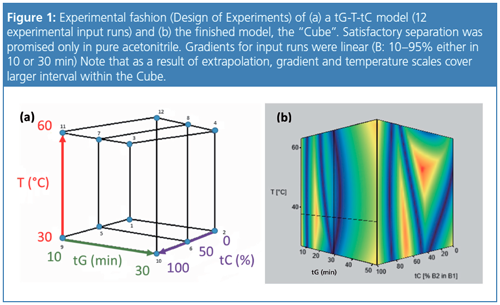
Selection of Modelling Parameters: Isoflavons are oestrogenic-like compounds that in soybeans can represent in four forms: aglycon- (GE, DE, GLE), glycosyl- (GI, DI, GLY)-, acetyl- (AGI, ADI, GLY), and malonyl-forms (MGI, MDI, MGLY), giving a total sum of 12 isoflavon-varieties. As these forms contain no dissociable groups, ternary composition (tC) was advised as a third modelling parameter as well as gradient time (tG) and temperature (T). Figure 1(a) depicts the experimental fashion of the Design of Experiments (DoE) and the required 12 runs for the tG-T-tC Design Space (Figure 1[b]).
Results
During the analyis only nine isoflavone peaks were detected, in addition to one unidentified matrix peak. Using the software, the movements of these peaks under different conditions (DoE) were followed up visually.
On the colourized maps, red areas indicate those fortunate combinations of temperatures and gradient times where, as a result of better peak spacing for the least resolved peak (critical peak pair), higher resolution than 1.1 could be expected. (Figure 1[b] and 2[a]). Note that this critical resolution value was selected arbitrarily.

Figure 2(a) and 2(b) show that a changing gradient profile makes a simultaneous change in the resolution map too. The gradient profile can be altered by the user (in this case we see a multistep method from reference 11) or be automatically optimized by the software. As every gradient step increases the uncertainty of a method’s performance, linear gradients should be preferred whenever it is possible. In this case, a simple softwareâpredicted optimum linear gradient (B: 11g27% in 6 min) provided an improved resolution with the same installation (column, equipment), compared to a relevant method from the literature (11) (Rs,crit: 0.97g1.21). The corresponding model (12 input experiments) including the experimental confirmations were accomplished with the automation module of the software and found to be in an excellent agreement (Figure 3).
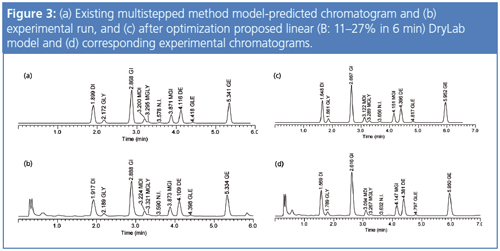
For the proposed working point, a robustness study was implemented (Figure 4). The critical resolution limit was set to 1.0 (slight partial overlap allowed). At the defined specification limits, 100% of the runs would have performed better than Rs,crit = 1.0 in routine work.
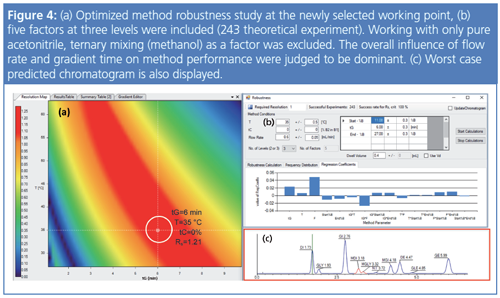
Conclusion
The main aim of this study was to reveal the untapped potential of HPLC-modelling from pharmaceutical to food analysis. Since every food sample shows a certain level of diversity and dynamism, the appearance of interfering matrix peaks or missing peaks should be expected. Therefore, direct adoption of methods from the literature may not always offer the best available analytical performance, and to achieve a reliable and well-performing analysis, HPLC-modelling should be considered. This approach produces simple, fast, and robust methods, as well as a reduction in method development time (7–9).
Acknowledgement
The authors thank Shimadzu Europe Corporation and the Budapest University of Technology for making this research possible.
References
- http://www.chromatographyonline.com/market-profile-latin-american-separation-market
- http://www.chromatographyonline.com/chinese-separation-market
- H. Heinzen, L.M.L. Nollet, and A.R. FernandezâAlba, Multiresidue Methods for the Analysis of Pesticide Residues in Food (CRC Press, 2017).
- https://www.fsis.usda.gov/wps/wcm/connect/87680e50-d76b-407b-9d94-d2ecc37b3cd0/CLG_AVR_04.pdf?MOD=AJPERES
- https://www.fda.gov/Food/FoodScienceResearch/LaboratoryMethods/ucm2006950.htm
- http://apps.who.int/medicinedocs/documents/h1791e/h1791e.pdf
- E. Tyteca, J.-L. Veuthey, G. Desmet, D. Guillarme, and S. Fekete, Analyst141, 5488–5501 (2016).
- R. Kormány, I. Molnár, and J. Fekete, J. Pharm. Biomed. Anal.135, 8–15 (2017).
- A. Schmidt and I Molnár, J. Pharm. Biomed. Anal.78–79, 65–74 (2013).
- M. Zhao, Y. Ma, L.-I. Dai, D.-I. Zhang, J.-H. Li, W.-X. Yuan, Y.-L. Li, H.-J. Zhou, and D.-L. Zhang, Food Analytical Methods6(1), 69–75 (2013).
- N. Toro-Funes, I. Odriozola-Serrano, J. BoschâFusté, M.L. Latorre-Moratalla, M.T. Veciana-Nogués, M. Izquierdo-Pulido, and M.C. Vidal-Carou, Food Chemistry135(4), 2832–2838 (2012).
Arnold Zöldhegyi holds a master’s degree in biochemical engineering. Having spent two years in the HPLC group at Budapest’s University of Technology led by renowned Chromatographer Jenö Fekete, Arnold gained extensive theoretical and practical knowledge in the field of analytics. The author currently works at the Molnár-Institute as a Graduate Research Assistant and Scientist. Direct contact: arnold.zoeldhegyi@molnar-institute.com
Imre Molnár is founder and president of Molnár-Institute for Applied Chromatography. Holding a PhD from Universität des Saarlandes, Dr. Molnár worked as a postdoc in the research team of Csaba Horváth at Yale University, resulting in numerous publications such as the theory of solvophobic interactions. After returning to Europe he founded the Institute for Applied Chromatography in Berlin. Later, together with Lloyd Snyder, he focused on in-silico method development resulting in the software DryLab. Since then, more than 200 peerâreviewed papers on DryLab’s scientific and industrial application have been published. Direct contact: imre.molnar@molnar-institute.com
Hans-Jürgen Rieger is vice president and product manager of the MolnárâInstitute. He has been working there since 1999 as a chemist, specializing in software programming. In cooperation with Dr. Molnár, he is responsible for the development of new modules of DryLab for better peak tracking, visualizing the design space, and robustness calculations as well. He also teaches DryLab courses on an international scale.
E-mail:info@molnar-institute.comWebsite: www.molnar-institute.com
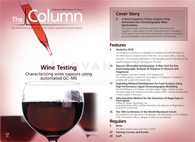
Accelerating Monoclonal Antibody Quality Control: The Role of LC–MS in Upstream Bioprocessing
This study highlights the promising potential of LC–MS as a powerful tool for mAb quality control within the context of upstream processing.
Analytical Challenges in Measuring Migration from Food Contact Materials
November 2nd 2015Food contact materials contain low molecular weight additives and processing aids which can migrate into foods leading to trace levels of contamination. Food safety is ensured through regulations, comprising compositional controls and migration limits, which present a significant analytical challenge to the food industry to ensure compliance and demonstrate due diligence. Of the various analytical approaches, LC-MS/MS has proved to be an essential tool in monitoring migration of target compounds into foods, and more sophisticated approaches such as LC-high resolution MS (Orbitrap) are being increasingly used for untargeted analysis to monitor non-intentionally added substances. This podcast will provide an overview to this area, illustrated with various applications showing current approaches being employed.
Prioritizing Non-Target Screening in LC–HRMS Environmental Sample Analysis
April 28th 2025When analyzing samples using liquid chromatography–high-resolution mass spectrometry, there are various ways the processes can be improved. Researchers created new methods for prioritizing these strategies.

.png&w=3840&q=75)

.png&w=3840&q=75)



.png&w=3840&q=75)



.png&w=3840&q=75)














